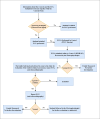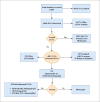Electrocardiogram screening for school children: a cross-sectional, population-based study
- PMID: 40189851
- PMCID: PMC11973435
- DOI: 10.5144/0256-4947.2025.69
Electrocardiogram screening for school children: a cross-sectional, population-based study
Abstract
Background: Identification of life-threatening arrhythmogenic disorders, which may present during infancy, childhood, or later stages, enables the early initiation of effective preventive therapies. Electrocardiogram (ECG) screening may detect conditions that elevate risk of sudden cardiac death (SCD) at an early stage.
Objectives: This study aims to assess the prevalence, clinical significance, and characteristics of ECG abnormalities in a large population of schoolchildren. It also aims to determine whether ECGs performed during childhood can aid in the early detection of conditions associated with the risk of SCD.
Design: Population-based cross-sectional study.
Setting: A multicenter study conducted at King Faisal Specialist Hospital & Research Centre (KFSHRC) in Riyadh and Prince Sultan Cardiac Center-Qassim (PSCC-Q), Qassim, Saudi Arabia.
Methods: The study analyzed 12-lead ECGs performed on elementary school students 6-15 years old in Buraidah, Qassim region, Saudi Arabia. ECGs were recorded and interpreted following international standards. Children with abnormal ECG results were referred for full pediatric cardiology evaluation.
Main outcome measures: Prevalence of normal and abnormal ECG findings, including long QT intervals.
Sample size: 14 403 students.
Results: During the study period, ECGs were performed on 14 403 students (53.8% females). The mean age was 9.5±1.9 years, and the mean weight was 32.1±16.1 kg. Abnormal ECGs were identified in 468 students (3.3%), 271 of whom had complete clinical evaluation, including repeat ECG and echocardiography. The most common ECG abnormality was a prolonged QTc interval. The overall prevalence of abnormal ECG findings ranged from 0.7% to 2.04%, with long QTc intervals (460 msec or more) found in 0.4% to 1.6% of students.
Conclusions: Long QTc intervals (460 msec or more) were the most common ECG abnormality in school children, with an estimated prevalence of 0.4% to 1.6%. This study may serve as a model for large-scale, community-based, 12-lead ECG screening programs for children.
Limitations: Causality cannot be derived given the design, the potential for false positive and false-negative results, and the lack of genetic studies for children with prolonged QT intervals.
Conflict of interest statement
Figures
Similar articles
-
Can we screen for heart disease in children at public health centres? A multicentre observational study of screening for heart disease with a risk of sudden death in children.Eur J Pediatr. 2024 May;183(5):2411-2420. doi: 10.1007/s00431-024-05489-4. Epub 2024 Mar 8. Eur J Pediatr. 2024. PMID: 38459131 Free PMC article.
-
Comparison of the Limb-lead Electrocardiogram to the 12-Lead Electrocardiogram for Identifying Conditions Associated with Sudden Cardiac Death in Youth Athletes.Am J Cardiol. 2021 Aug 1;152:146-149. doi: 10.1016/j.amjcard.2021.04.030. Epub 2021 Jul 5. Am J Cardiol. 2021. PMID: 34237610
-
Prolonged QTc intervals on admission electrocardiograms: prevalence and correspondence with admission electrolyte abnormalities.Conn Med. 2007 Aug;71(7):389-97. Conn Med. 2007. PMID: 17879860
-
Rationale and objectives for ECG screening in infancy.Heart Rhythm. 2014 Dec;11(12):2316-21. doi: 10.1016/j.hrthm.2014.09.047. Epub 2014 Sep 18. Heart Rhythm. 2014. PMID: 25239430 Free PMC article. Review.
-
Diagnostic cost-effectiveness of a two-stage cardiovascular evaluation program in young-adolescent athletes. Role of echocardiography.Curr Probl Cardiol. 2024 Sep;49(9):102724. doi: 10.1016/j.cpcardiol.2024.102724. Epub 2024 Jun 24. Curr Probl Cardiol. 2024. PMID: 38925205 Review.
References
-
- Mahle WT, Newburger JW, Matherne GP, Smith FC, Hoke TR, Koppel R, et al. . Role of Pulse Oximetry in Examining Newborns for Congenital Heart Disease: A Scientific Statement from the AHA and AAP. Pediatrics [Internet]. 2009 Aug 1;124(2):823–36. Available from: http://pediatrics.aappublications.org/cgi/doi/10.1542/peds.2009-1397 - DOI - PubMed
-
- Sontag MK, Yusuf C, Grosse SD, Edelman S, Miller JI, McKasson S, et al. . Infants with Congenital Disorders Identified Through Newborn Screening — United States, 2015–2017. MMWR Morb Mortal Wkly Rep [Internet]. 2020 Sep 11;69(36):1265–8. Available from: http://www.cdc.gov/mmwr/volumes/69/wr/mm6936a6.htm?s_cid=mm6936a6_w - PMC - PubMed
-
- Plana MN, Zamora J, Suresh G, Fernandez-Pineda L, Thangaratinam S, Ewer AK. Diagnostic accuracy of pulse oximetry screening for critical congenital heart defects. Cochrane Database Syst Rev [Internet]. 2015 Oct 28; Available from: http://doi.wiley.com/10.1002/14651858.CD011912 - DOI - PMC - PubMed
-
- Vetter VL. Electrocardiographic Screening of All Infants, Children, and Teenagers Should Be Performed. Circulation [Internet]. 2014 Aug 19;130(8):688–97. Available from: https://www.ahajournals.org/doi/10.1161/CIRCULATIONAHA.114.009737 - DOI - PubMed
-
- Friedman RA. Electrocardiographic Screening Should Not Be Implemented for Children and Adolescents Between Ages 1 and 19 in the United States. Circulation [Internet]. 2014 Aug 19;130(8):698–702. Available from: https://www.ahajournals.org/doi/10.1161/CIRCULATIONAHA.114.008398 - DOI - PubMed
Publication types
MeSH terms
LinkOut - more resources
Full Text Sources
Medical



